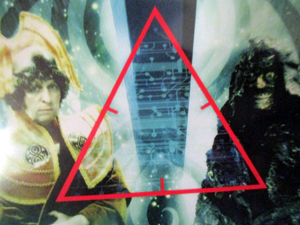The Deadly Assassin
“The Doctor is never more dangerous than when the odds are against him.” – The Master
 This story is a watershed moment for Doctor Who because it totally re-envisions Time Lord society and the Doctor’s relationship to them as well as establishing or at least reaffirming multiple aspects of Time Lord biology. It’s also a significant try at having a story without a particular companion for the Doctor (something Tom Baker apparently wanted to have continued which thankfully they did not). It’s also just a very well done storyline by Robert Holmes, perhaps his best of the whole series.
This story is a watershed moment for Doctor Who because it totally re-envisions Time Lord society and the Doctor’s relationship to them as well as establishing or at least reaffirming multiple aspects of Time Lord biology. It’s also a significant try at having a story without a particular companion for the Doctor (something Tom Baker apparently wanted to have continued which thankfully they did not). It’s also just a very well done storyline by Robert Holmes, perhaps his best of the whole series.
Right from the start, the story opens in an unusual way with a voice over and grandiose prologue. It sets the tone for a story full of pomp and circumstance and grand ideas. After the Doctor’s confusing visions of the future, we’re then thrown into the middle of Gallifrey like we’ve never seen it. While the Doctor’s surprisingly stealthy moves to put people off his trail feel like a clever spy show, it’s the bureaucratic machine with chancellory guards and castellans and other politics that are really surprising. No longer ominous god-like beings, these Time Lords are a subset of a larger Gallifreyan society—a ruling elite of sorts—with all of the associated squabbles and foibles of an archaic society. This change upset many who thought the Time Lords should remain mythic, nearly omnipotent beings, but I think Holmes really wanted to emphasize the staleness of the old society that the Doctor had rejected by leaving.
The story purposefully has hints of Manchurian Candidate which adds to our confusion of what is going on when the Doctor seems to shoot the president down. Is he being controlled to do these things? The dark figure appearing to guide the Doctor’s steps adds to that mystery even more. Though not the most dynamic of actor portrayals, Robert Holmes creates a good example of his famous double act with the team of crusty Castellan Spandrell and Egin. Their exposition explains much to us of the Doctor’s circumstances and they come to be quite the allies.
The highlight of the story is of course the incredibly tense battle of wits between the Doctor and his adversary in the Matrix. I’d forgotten just how gritty those scenes are. The Doctor is not light and laughing here but viciously fighting for his life. There are so many odd and random images, many specifically designed to frighten kids like clowns and spiders and trains, but the cat-and-mouse game of the hunt is especially gripping. It’s also brilliant to have the Doctor seem to be able to deny the reality (as we’ve seen him do time and time again in other false worlds) and have his bullet wound disappear—only to have it disappointingly reappear as it’s confirmed that he won’t be able to battle his invisible enemy by strength of will alone.
Also a striking part of the story is the reintroduction of the Master and the decision to have him appear as little more than an emaciated burned-out corpse. Gone is the suave villain we once knew and now just a scary figure who lives only by the strength of his hate. His callous disregard for pleading Goth, simply because he doesn’t have time to remove him from the Matrix before destroying it, is particularly harsh. The large scale nature of his plan to extend beyond his last regeneration—and how that ties in to the even larger mythos of Time Lord society and Rassilon—are very interesting and will return in stories to come.
There’s also just some fun dialogue like Spandrell’s sarcastic dressing down of Hildred for his mistakes (“A clever stratagem, Hildred. You’re trying to confuse him, I take it?”) or when Borusa reaffirms the political sewer that is Gallifrey by affirming that they will “adjust the truth” of the days events to reflect what they need it to.
Best (or worst) unsettling moment:
Much of the chase scene through the Matrix is thrilling and even gruesome at times. It’s a standout part of this story. As a kid, the beginning scenes, particularly where the Doctor appears to be the assassin, made be very confused and uncomfortable as well.
Firsts:
So much of Time Lord lore:
- Iconic Time Lord collared robes
- CIA (Celestial Intervention Agency)
- Rassilon
- The Matrix
- The Eye of Harmony
- Thirteen lives
- Time Lord biodata
- Shabogans
- Doctor as almost Time Lord President
- First mention of artron energy
Regrets:
I do wish there’d been a better explanation shown of what the Doctor had seen and was shooting at from the gallery. Though mentioned in dialogue, it also would have been nice to see more of the destruction and devastation of other parts of Gallifrey to coincide with the opening prologue of how bad the events were. And yes it’s a bit grating to have the mundane silliness of the Gallifrey news report or the old hearing impaired Time Lords undercut the seemingly grand society.
